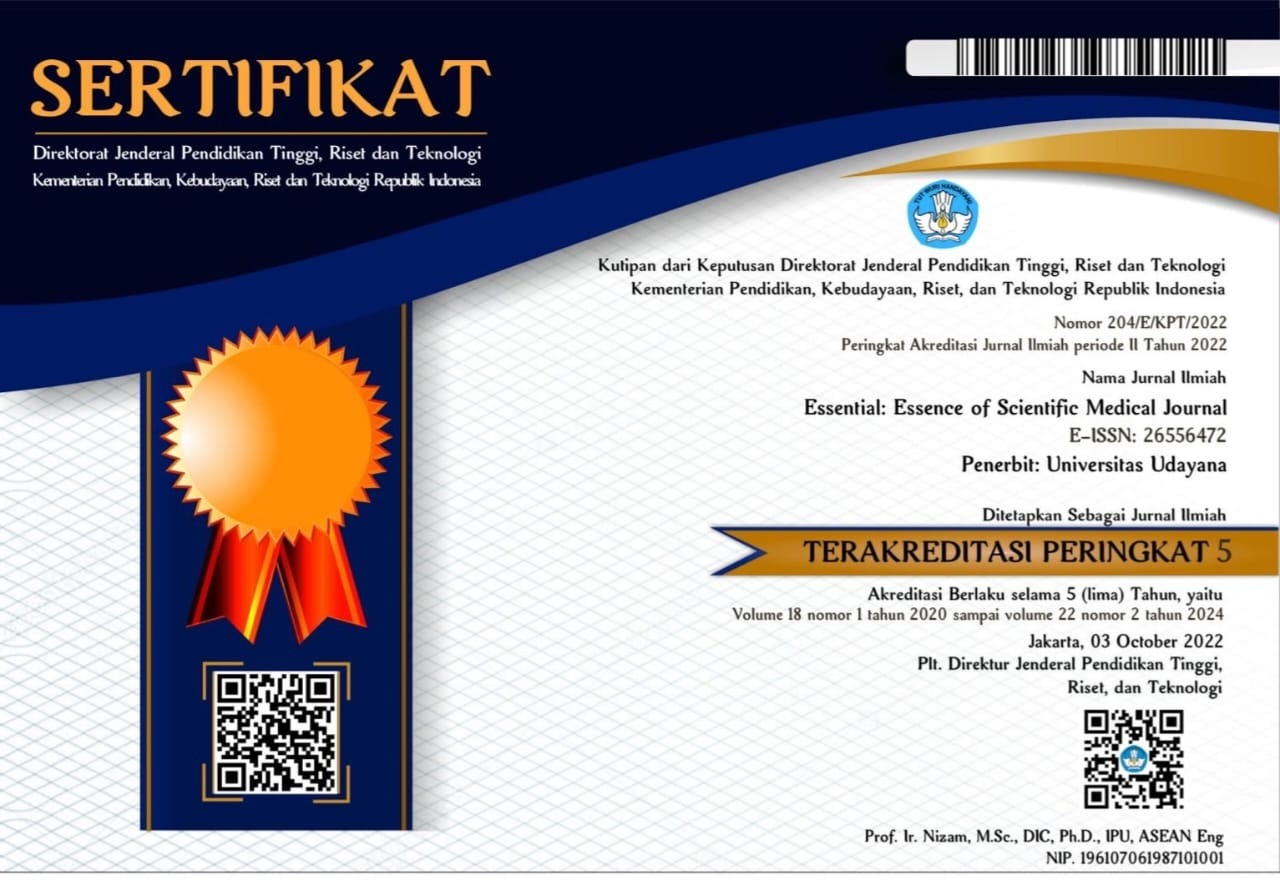EFEK BIOLARVISIDA EKSTRAK ETANOL BUAH CITRUS HYSTRIX TERHADAP LARVA AEDES AEGYPTI
Abstract
Pendahuluan: Infeksi dengue merupakan penyakit dengan vektor nyamuk dengan insidensi yang tinggi dan menyebabkan berbagai kondisi klinis dari yang ringan hingga berat. Membasmi larva nyamuk Ae. aegypti merupakan strategi umum untuk mencegah penyebaran infeksi dengue. Penelusuran bahan herbal sebagai biolarvisida penting dilakukan agar didapat bahan larvisida yang ramah lingkungan. Penelitian ini bertujuan untuk mengetahui efek biolarvisida ekstrak etanol buah Citrus hystrix terhadap larva Ae. aegypti.
Metode: Penelitian dilakukan menggunakan uji bioassay dengan larva Ae. aegypti instar III dan IV sebagai sampel. Pengujian dibagi menjadi 7 kelompok yakni kelompok kontrol, dan kelompok perlakuan pada konsentrasi 400, 800, 1200, 1600, 2000, dan 2400 ppm, tiap kelompok terdiri atas 20 ekor larva. Seluruh kelompok kemudian diamati pada 1, 24, dan 48 jam. Kematian larva dicatat dan data dianalisis untuk mengetahui efek biolarvisida, nilai LC50 dan LC95, dan hubungan dosis-efek.
Hasil: Total larva diujikan sebanyak 590 ekor, didapat total kematian larva 315 ekor dan 418 ekor setelah 24 dan 48 jam. Uji one-way ANOVA menghasilkan nilai F 26,03 dan 65,69 (p<0,05) masing-masing pada periode 24 dan 48 jam. Nilai R2 sebesar 0,745 dan 0,635 masing-masing pada periode 24 dan 48 jam (p<0,05). Nilai LC50 24 jam= 989,55 ppm, dan LC95 24 jam=2785,89 ppm sedangkan LC50 48 jam= 483,16 ppm dan LC95 48 jam= 1555,49 ppm.
Simpulan: Penulis menyimpulkan bahwa ekstrak etanol buah Citrus hystrix memiliki efek biolarvisida terhadap larva Ae. aegypti, hubungan dosis-efek yang linier, serta korelasi yang positif, kuat, dan signifikan.
Downloads
References
2. Shepard DS, Undurraga EA, Halasa YA, Stanaway JD. The global economic burden of dengue: a systematic analysis. Lancet Infect Dis. 2016;16(8):935–41.
3. Yoshikawa MJ, Kusriastuti R. Surge of dengue virus infection and chikungunya Fever in bali in 2010: the burden of mosquito-borne infectious diseases in a tourist destination. Trop Med Health. 2013;2005–11.
4. Suarjaya K. Profil Kesehatan Provinsi Bali 2017. Dinas Kesehatan Provinsi Bali. 2017;36.
5. Guzman MG, Alvarez M, Halstead SB. Secondary infection as a risk factor for dengue hemorrhagic fever/dengue shock syndrome: an historical perspective and role of antibody-dependent enhancement of infection. Arch Virol. 2013;158(7):1445–59.
6. Kovendan K, Murugan K, Vincent S. Evaluation of larvicidal activity of Acalypha alnifolia Klein ex Willd. (Euphorbiaceae) leaf extract against the malarial vector, Anopheles stephensi, dengue vector, Aedes aegypti and Bancroftian filariasis vector, Culex quinquefasciatus (Diptera: Culici. Parasitol Res. 2012 Feb;110(2):571–81.
7. Tsheten T, Gray DJ, Clements ACA, Wangdi K. Epidemiology and challenges of dengue surveillance in the WHO South-East Asia Region. Trans R Soc Trop Med Hyg. 2021;115(6):583–99.
8. Rubianti I. Evaluasi Peran Juru Pemantau Jentik (Jumantik) Dalam Pemberantasan Vektor Demam Berdarah Dengue (DBD) Di Kota Denpasar Tahun 2017. ORYZA Jurnal Pendidikan Biologi. 2019;8(2):1–9.
9. Melo-Santos MA V, Varjal-Melo JJM, Araújo AP, Gomes TCS, Paiva MHS, Regis LN, et al. Resistance to the organophosphate temephos: mechanisms, evolution and reversion in an Aedes aegypti laboratory strain from Brazil. Acta Trop. 2010;113(2):180–9.
10. Pavela R, Maggi F, Iannarelli R, Benelli G. Plant extracts for developing mosquito larvicides: From laboratory to the field, with insights on the modes of action. Acta Trop. 2019;193:236–71.
11. Bansal SK, Singh K V, Sharma S, Sherwani MRK. Laboratory observations on the larvicidal efficacy of three plant species against mosquito vectors of malaria, dengue/dengue hemorrhagic fever (DF/DHF) and lymphatic filariasis in the semi-arid desert. J Environ Biol. 2012;33(3):617.
12. Koul O. Plant biodiversity as a resource for natural products for insect pest management. Geoff, M, Gurr, GM, Wratten, SD, Snyder, WE & Read, D MY (Eds), Biodiversity and Insect Pests: Key Issues for Sustainable Management John Wiley & Sons, Ltd. 2012;85–105.
13. Adrianto H. EFEKTIVITAS EKSTRAK DAUN JERUK PURUT (Citrus hystrix), JERUK LIMAU (Citrus amblycarpa), DAN JERUK BALI (Citrus maxima) TERHADAP LARVA Aedes aegypti. Aspirator. 2014;6(1):1–6.
14. Mya MM, Zarzar A, Chitthat N, Aye WO, Than MH, Sein T, et al. Larvicidal, Ovicidal and repellent effect of Citrus hystrix DC (Kaffir lime) fruit, peel and internal materials extracts on Aedes aegypti mosquitoes. Journal of Biological Engineering Research and Review. 2017;4(1):34–43.
15. Wikandari RJ, Surati S. Efek Ekstrak Kulit Jeruk Purut (Citrus hystrix DC) terhadap Morfologi dan Histologi Larva Aedes aegypti. ASPIRATOR - Journal of Vector-borne Disease Studies. 2018;10(2):119–26.
16. Adrianto H, Yotopranoto S, Hamidah H. EFEKTIVITAS EKSTRAK DAUN JERUK PURUT (Citrus hystrix), JERUK LIMAU (Citrus amblycarpa), DAN JERUK BALI (Citrus maxima) TERHADAP LARVA Aedes aegypti. ASPIRATOR - Journal of Vector-borne Disease Studies. 2014;6(1):1–6.
17. Mya MM, Aye YY, Oo AW, Saxena RK. Effect of Citrus hystrix DC Leaves Ethanol Extract on Larvae of Aedes aegypti. Journal of Biological Engineering Research and Review. 2015;2(2):1–6.
18. Ansori ANM, Adrianto H, Hamidah H. Biolarvicidal effectivities of polar fraction extract from Citrus hystrix and Citrus aurantifolia leaf against Culex quinquefasciatus. Journal of Disease Vector. 2018;12(1):33–8.
19. KEMENKES. Farmakope Herbal Indonesia. Jakarta: Departemen Kesehatan Republik Indonesia. 2008;
20. Ochoa SA, Basurto JC, Valdez LMR, Torres LES, Torres BN. In vitro and in silico studies of terpenes , terpenoids and related compounds with larvicidal and pupaecidal activity against Culex quinquefasciatus Say ( Diptera : Culicidae ). Chem Cent J. 2018;1–21.
21. Inaba K, Ebihara K, Senda M, Yoshino R, Sakuma C, Koiwai K, et al. Molecular action of larvicidal flavonoids on ecdysteroidogenic glutathione S-transferase Noppera-bo in Aedes aegypti. BMC Biol. 2022 Feb;20(1):43.
22. Sutthanont N, Choochote W, Tuetun B, Junkum A, Jitpakdi A, Chaithong U, et al. Chemical composition and larvicidal activity of edible plant-derived essential oils against the pyrethroid-susceptible and -resistant strains of Aedes aegypti (Diptera: Culicidae). Journal of Vector Ecology. 2010;35(1):106–15.
23. Truong DH, Nguyen DH, Ta NTA, Bui AV, Do TH, Nguyen HC. Evaluation of the use of different solvents for phytochemical constituents, antioxidants, and in vitro anti-inflammatory activities of severinia buxifolia. J Food Qual. 2019;2019.
24. Pandiyan GN, Mathew N, Munusamy S. Larvicidal activity of selected essential oil in synergized combinations against Aedes aegypti. Ecotoxicol Environ Saf [Internet]. 2019;174(November 2018):549–56. Available from: https://doi.org/10.1016/j.ecoenv.2019.03.019


 SUBMISSION
SUBMISSION
















